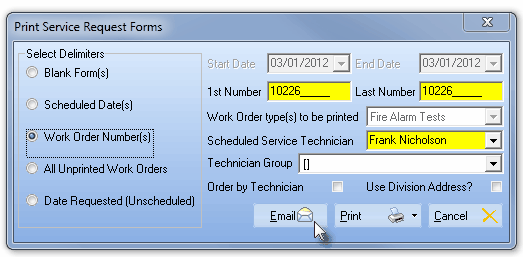| □ | The three sets of Special Icons on the top of the Service Request Form are listed below - along with the purpose of the Icons in each set. |



Service Request Form - Special Icons and Options
| • | Navigation related Icons: |
| 1. | Move from record to record manually (Beginning, Previous, Next, Last) |
| 3. | Search for a specific Work Order record |
| 4. | Refresh the currently displayed Work Order data. |
| 2. | Print a Service History |
| 3. | View the History of Invoices Created/Modified for this Work Order. |
| 6. | Order Inventory for a new, or existing Work Order |
| 1. | Show Total displays the Total Balance Due for this Work Order |
| 2. | E-Payments provides an instant method to get Paid for the Total Balance Due by E-Payment. |
| □ | Navigation and related Icons |

| • | These Navigation Menu Icons provide the normal Record Movement, New, Edit, Delete, Cancel, Save, Search and Refresh options: |
| 1. | Move from record to record manually, as required |
| 2. | Add, Modify, Save and/or Delete a Work Order |
| o | An Authorize Transaction dialog may be displayed in which case the User must Specify the reason for the Modification. |
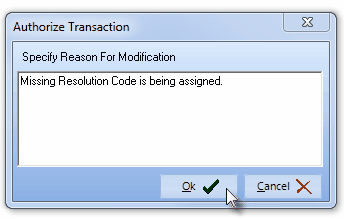
Authorize Transaction - Specific Reason For Modification
| o | Work Order has been Completed or Invoiced! - Confirm that these changes are required by Clicking the Yes button. |
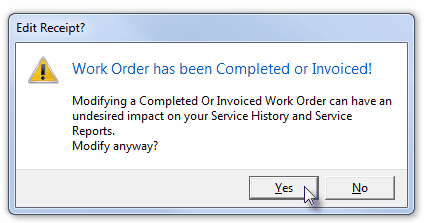
| o | A record of these changes will be posted to the Changes History for this Work Order (see the "Work Order Options" section's item #3 "View the History" below). |
| 3. | Search for a specific Work Order record |
| ▪ | Click the Search Icon (the Magnifying Glass) to open the Locate Field Value dialog: |

| ▪ | The Locate Field Value dialog provides a powerful search utility for finding a specific Service Request. |
| o | This utility is provided when the Table View tab contains a list that is too long to use for locating a specific Work Order. |
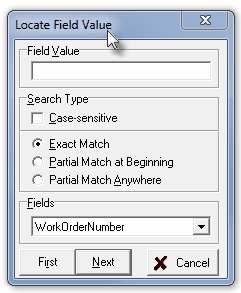
Locate Field Value dialog
| ▪ | Field Value - Enter the expression that would limit which record(s) would be included in this list. |
| ▪ | Search Type - Select the type of search that should be performed. |
| o | Case Sensitive - Check this box to have your Field Value you enter to be Case Sensitive. |
| o | Exact Match - The Field Value entered must match the actual information in the selected Field precisely. |
| o | Partial Match at Beginning - TheField Value entered must match the actual information in the selected Field from the beginning of the entry up to the length of the data you entered. The Field Value filter does not have to match anything beyond the length of your entered filter itself. |
| o | Partial Match Anywhere - The Field Value entered must match the actual information in the selected Field somewhere within entry. The Field Value filter does not have to match anything before or after the filter phrase itself. |
| ▪ | Fields - Use the Drop-Down Selection List to Choose the Field Name that the entered Field Value should match. |
| o | This is a long list so you may want to use the Slide Bar on the right to locate the desired field name. |
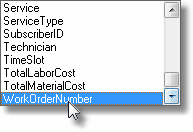
| ▪ | First, Next - Click the appropriate button to move the record pointer4to the first, or next match, as appropriate. |
| o | The Locate Field Value dialog will Close and the appropriate record will be displayed. |
| o | Repeat this process as needed. |
| ▪ | Cancel - Click the Cancel button to abort the Search. |
| 4. | Refresh will update the Service Request Form with the most current version of the Work Order data. |

| • | These Work Order Options Icons include Printing, Scheduling, History review, Inventory ordering and Work Order Chaining functions: |
1. Print the currently displayed Work Order

Print Service Request form Print and Email buttons
| o | The Start and End Dates will default to Today and cannot be changed. |
| o | The 1st and Last (Work Order) Number will be that of the current Service Request and should not be changed. |
| o | The Technician selected for this Service Request will be inserted automatically, but may be changed using the Drop-Down Selection List provided, if appropriate (e.g., more than one Technician has been assigned to this Service Request and that other Technician needs a copy, too). |
| ▪ | Print - Click the Print button at the bottom of the Print Service Request Forms dialog to Preview and optionally Print (to a File or a Printer) this Service Request. |
| ► | Note: When the UseDivisionAddress option is set to True ("T"), if a Subscriber has been assigned to a Division, except on an Installation Order, that Division's Address will be printed as the Company Address on a printed Service Request Form. |
| ▪ | Email - Click this Email Icon (the Envelope) on the Print Service Request Forms dialog to Email this Work Order to the assigned Technician. |
| o | Your email application will load automatically. |
| o | Enter the email address where indicated. |
| o | Click Send - the Work Order information will be attached to the Email message, automatically. |
2. Print a Service History

| ▪ | Click the Service History Icon. |
| ▪ | This selection will immediately list all Work Orders completed for this Subscriber. |
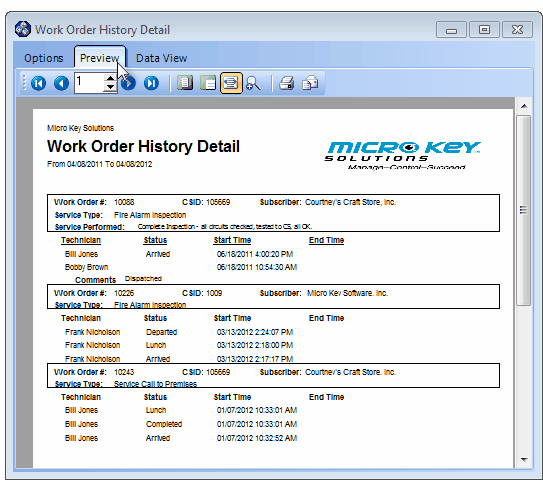
Work Order History report sample
3. View the History : Click the View History Icon to see a list of any authorized changes, the User who made them, and when they were made to this Work Order after it was Invoiced and/or marked as Completed.

| ▪ | Click the View History Icon. |
| ▪ | The Accounting History dialog will be displayed. |
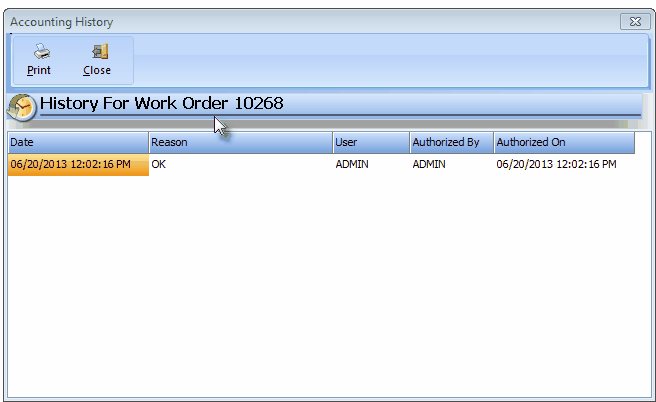
Accounting History Form - Column Headers & Modified Service Request sample
| ▪ | You may Print this log whenever necessary. |
| ◆ | This option immediately sends the information to your default Printer, with no Preview option offered. |
| ▪ | Click Close to exit the Accounting History dialog. |
4. Schedule a Work Order

5. Chain a new service issue to a previously entered Service Request
| o | Using either the Table View tab or the Search Icon described above, Select the Service Request record to be worked on in conjunction with the Subscriber's new service issue. |

| ► | Note: In many cases, the User must Authorize this Transaction. |
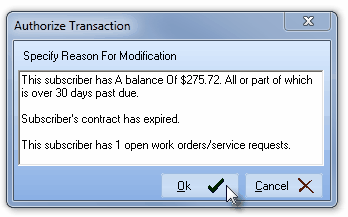
Authorize Transactions dialog
Click the OK ü button to confirm the Authorization.
| o | When the Chain Icon is Clicked (and after an Authorization is granted, if required), a New Service Request record is created which will contain the information from the currently selected (previously entered but not yet Completed) Work Order, including any special Scheduling Instructions that may have been entered. |
| o | Be sure to Click the Save button ("ü") to record this new "Chained" Service Request. |
6. Order Inventory for the current Service Request:

| ▪ | Frequently, specific Inventory Items will be required to perform the requested service(s). |

| o | Click the Order Inventory Icon itself (not the Down-Arrow ‚) to open the Search Vendors dialog. |
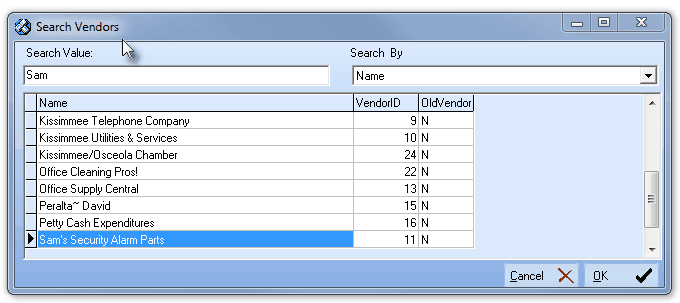
Vendor Search dialog
| o | Click the OK ü button to Close the Search Vendors dialog and display the Purchase Order Form for that Vendor. |
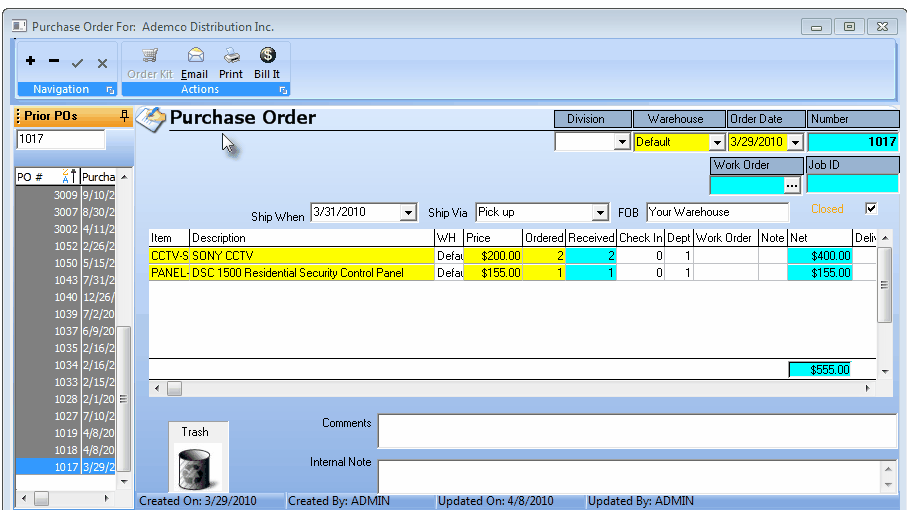
Purchase Order Form
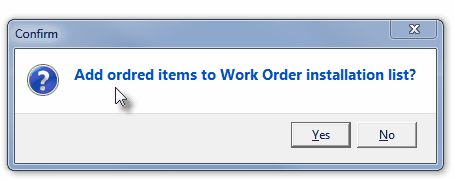
Add ordered items to Work Order installation list?
| o | Also see the "Inventory Usage from this Work Order" section below |
| □ | Payment related Icons: Click the Down-Arrow to the right of the Work Order Options box to open the Payment options box. |

| • | These two functions allow for the instant calculation of the various Charges that should be billed for the Service Request, and provide for the creation of an E-Payment Transaction for the Payment of the Service Request. |

1. Show Total - Display the Total Balance Due for this Work Order

| ▪ | Click the Show Total Icon to display this information. |
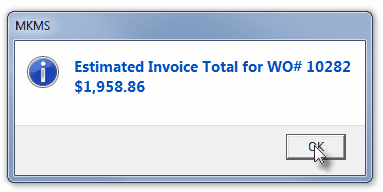
2. Get Paid by E-Payment for the Total Balance Due.

| ▪ | Click the E-Payment Icon to display the E-Payments Form. |
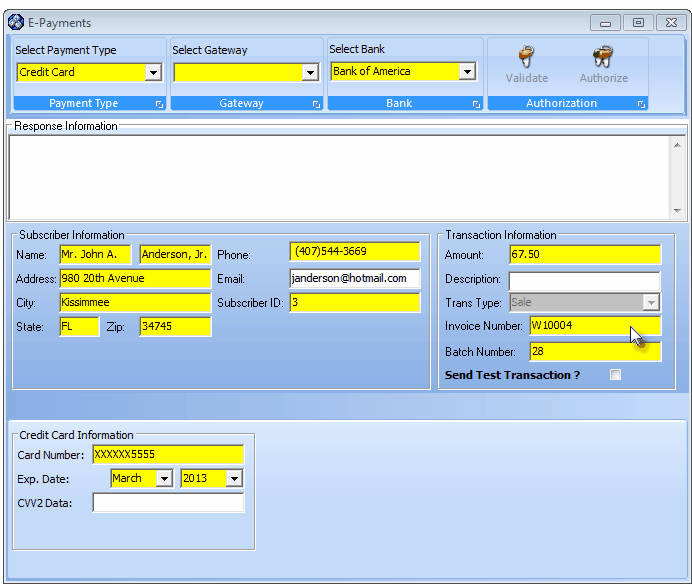
E-Payments Form - Opened from Service Request Form
| ▪ | See the E-Payments chapter for detailed information. |
| ▪ | The main difference will be found in the Transaction Information section of the E-Payments Form |
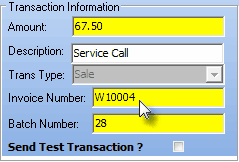
Transaction Information
| ▪ | Amount - Enter the Amount to be charged to the Credit Card or Bank Account |
| o | When the E-Payment Form is opened from a Service Request Form, that Work Order's Balance Due will be inserted automatically. |
| ▪ | Description - Enter a brief description of the reason for this charge. |
| ▪ | Trans Type - By default, this will be Sale. |
| ▪ | Invoice Number - By default, this will be the Work Order Number preceded by a "W". |
| ▪ | Batch Number - By default, this will be the Calendar's Day Number for Today. |
| o | Enter the appropriate Batch Number to be assigned to this payment. |
| ▪ | Send Test Transaction - Check this box to transmit a preliminary Test Transaction to confirm the Credit Card or Bank Account Information |
| □ | Inventory Usage from this Work Order - If the Service Request was created and the Inventory was Posted while using the Legacy Job Costing system, the Order Inventory displays the Inventory item(s) used on the Work Order if that Inventory was recorded using that Legacy Job Costing version. |

Inventory Usage list displays Usage recorded within the Legacy Inventory Tracking System








